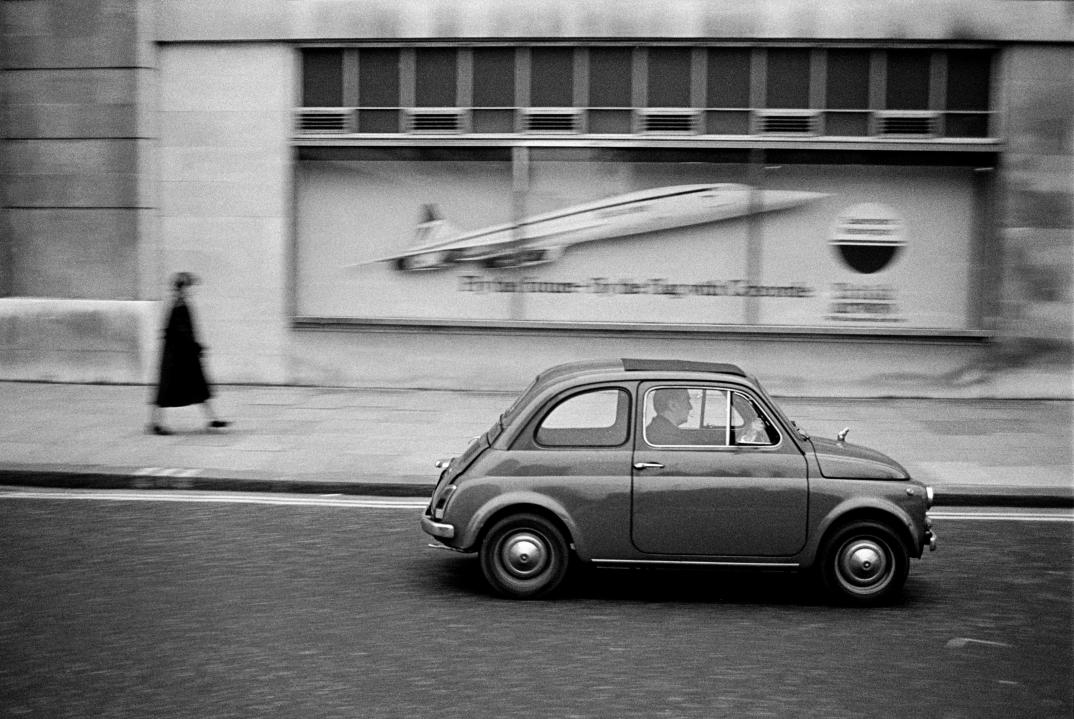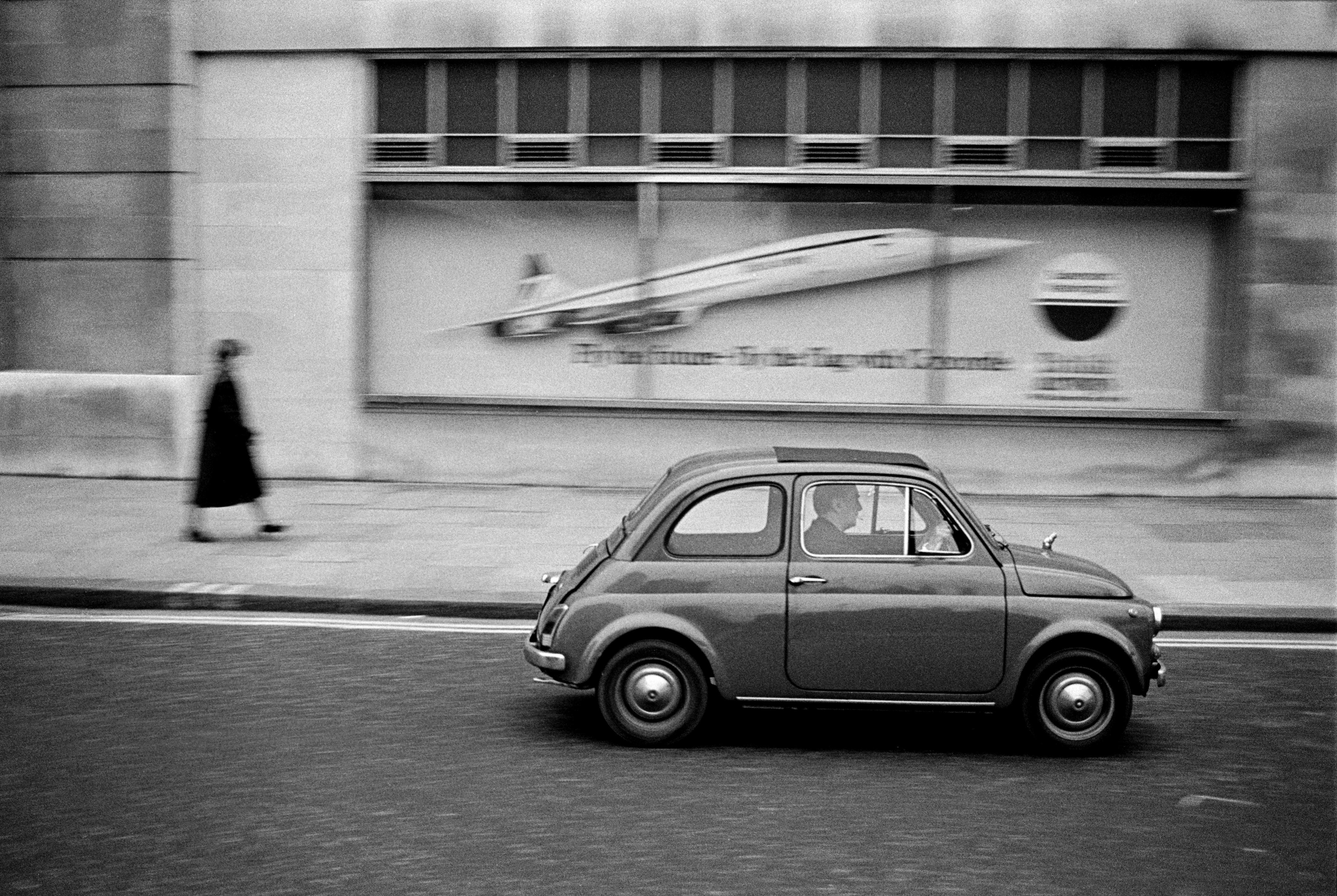On visits to the continent as a child, what struck me was the strangeness of other European countries. Going to France or Italy, pre-internet, you cut off your connections to the outside world, and even got the British news a day or two late. People ate horse meat, tortellini in brodo or croque monsieurs, and the kids drank Orangina and watered down wine. The smell of black tobacco smoke – dignified and with a kind of ancient wisdom to it – seemed to permeate every public building. But what you also noticed was the cars – Renault 4s on the Riviera, Citroen DS-23s in Paris, and in Italy, overwhelmingly, the tiny, toy-like Fiat 500, a design classic thrumming with character and a part of postwar history.
Fiat 500s were advertised against a backdrop of the Alps, the open motorway, the narrow streets of Central Rome
The Fiat cinquecento – or ‘cinquino’ as it’s often known – has been with us for nearly 70 years now, and in Italy older models are still very much on the road. Staying in a provincial town in Puglia, you see few Ferraris or Lamborghinis, but these vintage 500s, most now at least 50 years old (Fiat stopped production of this model in 1975) crop up each day on the streets nearby. So many of them were made in their heyday – just under four million in about 20 years – that old models are easy to pick up. There’s presumably a small Dolomite of spare parts and most Italian mechanics, I would guess, know the ways of their engines and bodywork like a blind man knows braille.
The car and its story are woven into modern Italian history. Following the success of the similarly shaped but faster, larger Fiat 600, there was high demand, in a country worn out by postwar austerity but hungering for the fruits of peace, for an affordable car for the masses. The task of designing one fell to engineer Dante Giacosa, Roman by birth but with roots in Piedmonte, where Fiat – ‘Fabbrica Italiana Automobili Torino’ (Italian Automobile Factory Turin) – still has its headquarters. Giacosa certainly looked the part: lean, immaculately tailored and – a nice touch – with a degree in classics, later crediting his knowledge of Greek and Latin for ‘a sense of measure and balance without which I could not have done my job.’ His brief wasn’t just to cut costs for Italian drivers but to use up as few of the country’s resources as possible (the sunroof which came as standard on the Fiat 500 was simply to save steel, and more a matter of austerity than hedonism). Its compact 13hp engine, located at the back of the car, was capable of a ferocious top speed of 58mph – you can still see them chugging and struggling to keep up with modern cars – and on its spartan dashboard are just a speedometer and a few switches. To the average Italian, this spelt freedom, and after a few modifications the cinquecento was selling like hot focaccia.
A new era had begun in Italian motoring and a genuinely popular (and economical car) was bringing La Dolce Vita to more and more drivers. The ads spelt it out, showing a bright red 500 moving jauntily through a crowd of pricier, drabber vehicles, or a couple in a pastel pink version, spied through the open roof beneath a blazing Mediterranean sun. Fiat 500s were advertised against a backdrop of the Alps, the open motorway, the narrow streets of Central Rome. A beautiful girl (of the Gina Lollobrigida variety) stood up and waved through its open roof like a sex goddess. The car, in its first incarnation, would sell nearly four million models, and go on to appear onscreen countless times – from Inspector Morse to Bruce Robinson’s 2011 The Rum Diary, and last year’s film from the Mission Impossible franchise. It proved especially popular in cartoons where, with its dinky, dogged little face, it simply looks like another character (in Pixar’s Cars, both new and old editions appeared together, like nonno and grandchild). Life, you feel, would be a bit more fun with an old cinquecento, which in their home-country can be picked up, in decent nick, for about £4,000. Though you’d think twice before taking it even on the slow lane of the motorway, its status as a classic car exempts it from the Ulez charge, and its tiny length (just under 3 metres long) makes it heaven to park.
Of course, for performance there’s no comparison with new Fiat 500 released in July 2007 (the 50th anniversary of the prototype’s launch) which is bigger, infinitely more comfortable, and has a 100hp engine eight times more powerful than the original. The launch of the reinvented cinquecento – an enduring hit since worldwide – was treated in Italy as a national event, with ad campaigns telling the people ‘If you’re Italian, you have to buy a Fiat’ and ‘The new Fiat belongs to all of us.’ In Liguria, there was a car rally of old cinquecentos into which the new model was flown by helicopter. At the official launch in Turin, 7,000 people from 63 countries attended. A special patriotic edition of the car was offered with side-stripes in the colours of the Italian flag – since then there have been versions sponsored by Gucci and Guerlain, and even one decorated by British artist Tracey Emin. There are Fiat 500 meet-ups in places like Hertfordshire and Minneapolis, and in Italy, for cinquecento owners. Like the Volkswagen Beetle and the Citroen 2CV, it belongs to that small group of foreign cars whose owners tend to hoot at each other in passing, and which are likely to be given a Christian name of their own – in a recent UK poll of drivers, ‘Fifi’ was the most popular, followed by ‘Bella’ and ‘Luigi.’
I barely notice Fiats in England – there’s something faintly Mr Beanish about them – but in Italy, that silver and burgundy badge, as recognisable as the Coke logo, as Italian as a Gaggia machine, starts to exert a powerful hold. So taken am I with the brand that readers won’t be surprised to learn, while in Puglia, I’ve finally succumbed and bought a Fiat 500 of my own. It’s bright red, about three inches long and purchased from a local toy-seller called Giuseppe. As souvenirs go, it’s a lot better than a plastic Colosseum or never-to-be-drunk bottle of Limoncello, and besides, as one 1950s advert for the cinquecento put it: ‘Bigger isn’t better… It’s just harder to park.’
This article is free to read
To unlock more articles, subscribe to get 3 months of unlimited access for just $5








Comments
Join the debate for just £1 a month
Be part of the conversation with other Spectator readers by getting your first three months for £3.
UNLOCK ACCESS Just £1 a monthAlready a subscriber? Log in